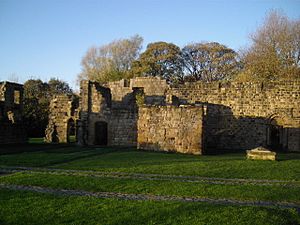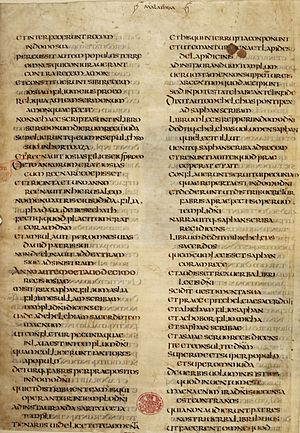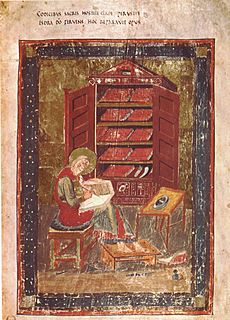Ceolfrith facts for kids
Quick facts for kids Saint Ceolfrid |
|
|---|---|

Remains of St Paul's Monastery, Jarrow, where Ceolfrid was Abbot.
|
|
| Born | 642 |
| Died | 716 monastery of Langres in Burgundy |
| Venerated in | Roman Catholic Church, Eastern Orthodox Church |
| Feast | 25 September |
Saint Ceolfrid (born around 642, died 716) was an important Anglo-Saxon Christian leader. He was an abbot, which is like the head of a monastery. Ceolfrid is famous for being the guardian and teacher of Bede, a very well-known historian and monk. Bede lived with Ceolfrid from when he was seven years old until Ceolfrid's death. Ceolfrid was the Abbot of the Monkwearmouth-Jarrow Abbey. He also played a huge part in creating the amazing Codex Amiatinus Bible. He passed away in Burgundy while traveling to give a copy of this special Bible to Pope Gregory II in Rome.
Contents
Ceolfrid's Early Life
Not much is known about Ceolfrid's early years. He likely wanted to join a monastic community because his brother, Cynefrid, was also very devoted to Christian monasticism. Historians believe Ceolfrid became a monk around 660, the year Cynefrid died.
Ceolfrid had strong family ties to monastic life. His cousin, Tunbert, was the first Abbot of Hexham Monastery. Ceolfrid spent his first four years as a monk at Gilling Abbey in North Yorkshire. His brother Cynefrid had also been there before going to Ireland. People described Ceolfrid as very devoted. He spent his time reading, working, and following monastic rules.
After four years, Ceolfrid left Gilling. He was looking for a monastery with even stricter rules. He soon joined a group of monks led by Wilfrid, who later became Saint Wilfrid. These monks were Benedictines at a monastery in Ripon. There, Ceolfrid learned more about how a monastery should be run. When he was 27, Ceolfrid became a priest. He worked hard to understand all parts of monastic life.
Working with Benedict Biscop

British Library, London.
Around 672 or 673, King Ecgfrith of Northumbria gave land to Benedict Biscop. This land was specifically for building a monastery. Biscop built his first monastery at Wearmouth. He chose Abbot Eosterwini (also called "Easterwine") to be his main assistant. It took eight years to build this monastery.
King Ecgfrith was so impressed that he gave Biscop more land. This was for a second monastery, Jarrow. The king wanted both monasteries to be managed as one.
Benedict Biscop asked Ceolfrid to join him during the building of the Wearmouth Monastery. Ceolfrid became Biscop's "most eager helper" from the very start. They also became close friends. It seems Biscop's invitation came at a good time for Ceolfrid. He had been thinking about leaving his old job. He was unhappy with the power struggles and "jealousies" there. He wanted to return to his own monastery, probably Ripon.
After the Jarrow Monastery was finished, Ceolfrid became the Abbot of St. Paul's Church there. Some reports say Ceolfrid took over Jarrow after it was built. Others say he was very important in directing the building of the monastery itself.
Benedict Biscop and Ceolfrid were very close friends. When Benedict sailed to Rome for the last time, he only chose Ceolfrid to go with him. This trip was important because it led to both abbots being remembered in the writings of The Venerable Bede. Ceolfrid also used the trip to learn more about his role. He felt Rome was a good place to understand his responsibilities.
Twelve years later, Abbot Eosterwini died. Ceolfrid was then chosen to be the only Abbot for both the Wearmouth and Jarrow Monasteries. This was a great honor. In 690, Benedict Biscop died after being sick for a long time. Ceolfrid then became the main leader of both monasteries. He worked hard to double the size of their libraries, which Abbot Benedict had started.
Ceolfrid and Bede

Bede came to live with Ceolfrid when he was only seven years old. He became Ceolfrid's student and friend. In Bede's early years at the twin Monasteries of Wearmouth and Jarrow (around 686), a terrible plague hit Northumbria. It affected much of the countryside, including the monasteries.
Ceolfrid and Bede seemed to be untouched by the sickness. They bravely took on the duties of caring for the sick and dying monks. They also worked together to keep the regular church services going when everyone else was scared. When the plague finally passed, the master and student worked to rebuild the monasteries. They were very successful. Bede stayed at Jarrow for most of his life. He never traveled more than 70 miles from the monastery. He was a loyal student until Ceolfrid's death. Bede himself died in Jarrow in 735.
The Codex Amiatinus Project
The Codex Amiatinus is the oldest complete copy of the Vulgate Bible. It shows the beautiful writing style of early British calligraphy. Creating the Vulgate was part of a plan to make the Wearmouth and Jarrow libraries even bigger.
Ceolfrid ordered three copies of this huge Bible manuscript to be made. One copy was meant for Pope Gregory II. The other two copies were to stay in the churches of Wearmouth and Jarrow. There are no official records that say the Bible made it to Rome. Instead, it is believed to have ended up in Florence, Italy. There, a Lombard Abbot named Peter gave it to the Abbazia di San Salvatore at Mount Amiata in Tuscany. It is thought that he changed the special note inside the book to say he donated it to the monastery. This happened in the 9th century. The document stayed at Mount Amiata until 1786. Then, it was moved to the Laurentian Library in Florence.
There is some debate about what exactly was in this Vulgate Codex. Over the last few hundred years, more pages that seem to belong to this text have been found in Britain. Some were even used as book wrappings. These new discoveries make scholars wonder about the total size of the codex. Some parts are still missing today.
Ceolfrid and the Picts
After 711, Nechtan mac Der-Ilei, the King of the Picts, asked Abbot Ceolfrid for advice. He wanted to change how Easter was celebrated in his kingdom. He hoped to make the date of Easter the same for everyone. By 716, both the Picts and the monks of Iona had started celebrating Easter in the same way as the wider Christian church.
Ceolfrid's Final Journey
Ceolfrid seemed to know that his life was coming to an end. He decided to step down from his role as abbot. Hwaetberht took his place. Ceolfrid then set sail for Rome. His goal was to deliver the Codex Amiatinus Bible to Pope Gregory II. He traveled as far as Langres in Burgundy, where he died on September 29, 716. He was buried there.

